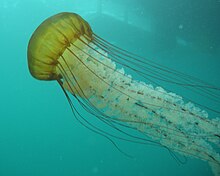Chrysaora fuscescens
| Chrysaora fuscescens | |
|---|---|
 |
|
| The Pacific sea nettle (Chrysaora fuscescens). | |
| Scientific classification | |
| Kingdom: | Animalia |
| Phylum: | Cnidaria |
| Class: | Scyphozoa |
| Order: | Semaeostomeae |
| Family: | Pelagiidae |
| Genus: | Chrysaora |
| Species: | C. fuscescens |
| Binomial name | |
|
Chrysaora fuscescens Brandt, 1835 |
|
Chrysaora fuscescens (commonly known as the Pacific sea nettle or West Coast sea nettle) is a common free-floating scyphozoan that lives in the East Pacific Ocean from Canada to Mexico.
Sea nettles have a distinctive golden-brown bell with a reddish tint. The bell can grow to be larger than one meter (three feet) in diameter in the wild, though most are less than 50 cm across. The long, spiraling, white oral arms and the 24 undulating maroon tentacles may trail behind as far as 15 feet. For humans, its sting is often irritating, but rarely dangerous.
Chrysaora fuscescens has proven to be very popular for display at public aquariums due to their bright colors and relatively easy maintenance. It is possible to establish polyps and culture Chrysaora in captivity. When provided appropriate aquarium conditions, the medusae do well under captive conditions.
Chrysaora fuscescens is commonly found along the coasts of California and Oregon, though some reside in the waters north to the Gulf of Alaska, west to the seas around Japan and south to the Baja Peninsula. The populations reach their peak during the late summer. In recent years, C. fuscescens has become overly abundant off the coast of Oregon, which is thought to be an indicator of climate change. However, others suspect that the population is increasing because of human influences to coastal regions.
In common with other cnidaria, Chrysaora fuscescens are carnivorous animals. They catch their prey by means of cnidocyst (or ) -laden tentacles that hang down in the water. The toxins in their nematocysts are effective against both their prey and humans, though it is typically nonlethal to the latter. Because C. fuscescens cannot chase after their prey, they must eat as they drift. By spreading out their tentacles like a large net, the sea nettle is able to catch food as it passes by. When prey brushes up against the tentacles, thousands of nematocysts are released, launching barbed stingers which release a paralyzing toxin into the quarry. The oral arms begin digestion as they transport the prey into the sea nettle’s mouth.
C. fuscescens feeds on a wide variety of zooplankton, crustaceans, salps, pelagic snails, small fish as well as their eggs and larvae, and other jellyfish. Due to their growing numbers, they seem to be reducing fish populations and have become nuisances to the fisherman of Oregon by clogging up fishing nets. Their dense swarms have also become problematic for scientific trawls and water intake.
...
Wikipedia
